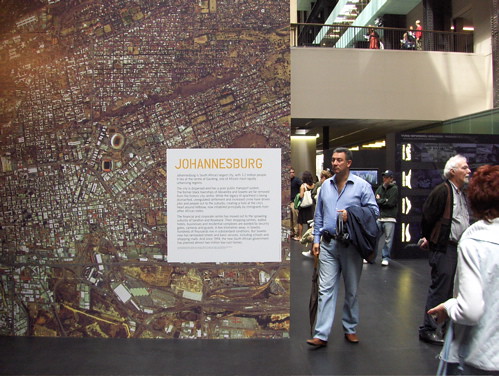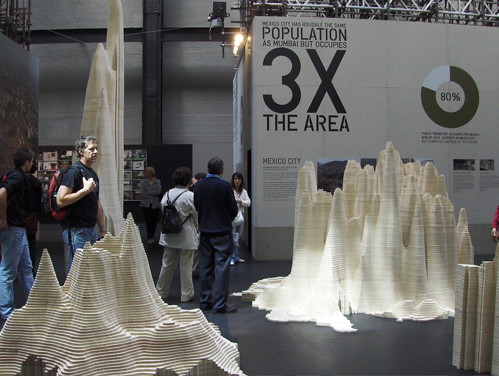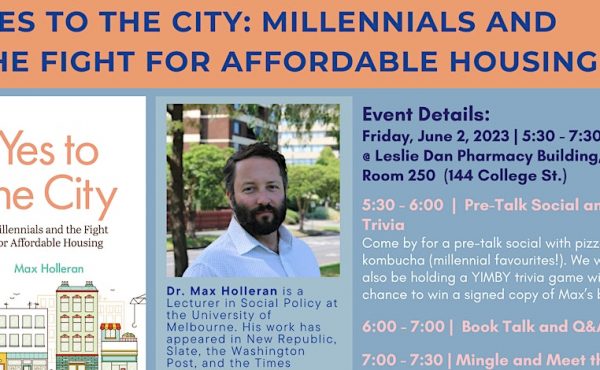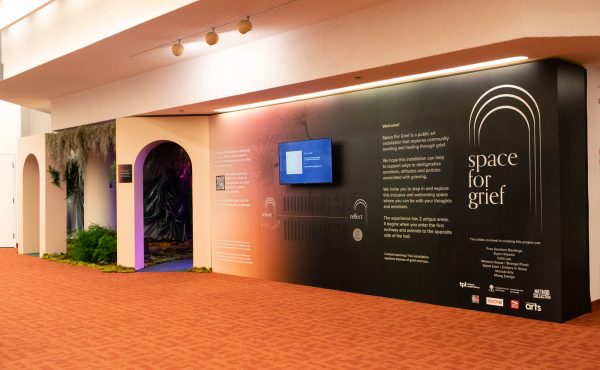
If you have the good fortune to visit the second greatest city in the world (after Toronto) this summer, you should head over to the Tate Modern in London where the Global Cities exhibit has taken over the massive and magnificent Turbine Hall (follow the link to the Tate site and lots of online material). It’s free, and I spent a few hours there last Wednesday, completely overwhelmed (yep, that’s the word) and excited. So exited that I walked by the Picassos, Warhols and Rothkos in a blur afterwards, hardly noticing, because they had nothing to do with cities.

Global Cities examines the “social and spacial” conditions in ten “large, dynamic cities” — Cairo, Istanbul, Johannesburg, London, Los Angeles, Mexico City, Mumbai, Sao Paulo, Shanghai and Toyko. Toronto isn’t included, but makes an appearance on a few maps and charts that look at other cities.

To those who follow city-stuff, some/much of the “facts” will be not be completely new, but the way they are presented — in such a larger-than-life way — was quite something. It reminded me a bit of the way Al Gore’s An Inconvenient Truth packaged climate change information: big and emphatic. Simple but fantastic things like a 25 meter wide projection screen with slow aerial pans over sprawling cities with a minimal blip-bloop electronic soundtrack to wall-size photographs of cities you can walk right up to, giving a sense of just how big some of them are, are wonderful. The exhibit focuses on five thematic lenses: size, speed, form, density and diversity.

Included among the information are a number of art pieces and films (such as Mixtacity by Nigel Coates, above. He created an alternative model of the London Thames Gateway in the near future that reminded me of two Toronto things: Marlena Zuber’s map included in the first uTOpia volume, and the UpBag (Upper Parkdale Benevelont Art Guild) Collective’s Soft City project that people may have seen at last year’s Toronto the Good party at Fort York).
What was most exciting was seeing the huge scale of it (arguably the Turbine Hall is the biggest permanent exhibition space in the world and it has been given over to this subject during the busiest season). It is sort of confirmation that all this interest in cities at the local level is on the right track. We argue about what buildings we like, and how crappy or how wonderful a public square is, but I think being from a place like Toronto, where there is so much genuine care about these issues — from big sprawling ideas all the way down to matters on the sidewalk out front of our homes — had me thinking we’re ahead of, or at, the curve here with our public conversations about these things. People might argue it’s a bit fluffy, and too much into the dramatic, big-font effect, but I think it’s emotionally helpful from time to time to see the stuff you’re into presented a Bruckheimer-blockbuster-big way. It might make the local battles easier to take, like losing a bike-lane to Case Oates or something — those things that can suck a person’s enthusiasm and energy. A visit to Global Cities confirms that the Oates style folks are on the wrong side of history (and maybe, more importanty, the wrong side of the Tate Modern).



10 comments
Cities are the greatest human creation. I never doubted this for a moment. If they are celebrated in a Buckminster-blockbuster-big way, I say that’s the least we can do.
PS: Cairo, Istanbul, Johannesburg, London, Los Angles, Mexico City, Mumbai, Sao Paulo, Shanghai and Toyko.
We can’t be included in that very definitive list of PoMo cities because we’re not in the 10 million club, but we are kind of in 2nd rank of the great Post Modern cities of the world.
London is sort of the crossroads of the world (sorry, NY) which kind of puts it in that list, but it’s the odd one out. It would be more at home on the New York, Vienna, Paris, Buenos Aires traditional ‘great cities’ list.
All the others are cities that just exploded in population in the last 50 years and are kind of polycentric and haphazardly planned. Toronto is one of these and that’s not a diss.
London really is a crossroads city isn’t it. When you’re there you do feel like it is the centre of the world. Probably be a hangover of the Empire — but also I think the British/European outward looking world view, compared to the inward looking American one, which drags on NYC (even though NYC is the least “American” of its cities).
Would really liked to have seen that.
Begs the question – is Toronto inward looking or outward looking?
The rest of Canada would accuse we’re inward, but I’ve never felt more Canadian, or more in touch with the rest of Canada, as I have since I moved here. And so many people here are from elsewhere (Canada and the world) so it leads to a lot of outward gazing.
As a middle power Canadians are much more like Europeans in their sensibility, and the tendency to be outward looking.
Toronto is a dichotomy. On one hand, I want to say that Toronto is one of the most outward looking cities in the world. All the right ingredients are here to make a first-tier international post-national metropolis. On the other hand, we have such a parochial municipal system and everyone in power seems to be inward looking and antiquated. Fresh ideas go to waste in this city like food left out on the picnic table on a hot day.
Some of the most inspiring ideas can come out of Toronto, but the intellectual establishment (which feels increasingly like its an appendage of U of T) is really old guard in a CanCon sort of way and sinks a lot of our potential.
I have seen the new guard and they are massing at the gates, ready to bust in any minute now.
Shawn, if what you say is true, I’ll be right there hammering away at the gates.
I’m going to echo what I said about U of T having something of a “Wal*Mart effect” on the intellectual community of our city. The university has pumped out many of our greatest thinkers but it is just so huge that it forms a bit of a monoculture of thought, which I find somewhat stifling.
When I was living in New York, I felt that the city was abuzz with ideas not simply because it was bigger and American, but because a lot of the people I met had gone to or taught at radically different schools around the city: Columbia, NYU, Hunter, Puck, the New School, Juilliard, Sarah Lawrence, the list goes on. In Toronto, U of T’s academic community just kind of steamrolls over everything and has had a heavy hand in creating the dominant Canadian class of intellectuals that run the show.
Toronto looks outward, but turns it’s back on the ROC. It’s always striving to be included in the great world cities list while turning up it’s nose at other parts of the country of which it purports to be capital in all but name as if they were poor relations.
I have spoken, er, typed.
How does it turn up it’s nose? I think that sounds like “bullshit,” as that TV show calls things of the same nature.